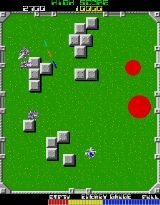
Grobda
Encyclopedia
is a multi-directional shooter arcade game
that was released by Namco
in 1984. It is a spin-off from Xevious
, as the player's tank first appeared in that - as an enemy.
The game runs on Namco Super Pac-Man
hardware but with a DAC
for speech. Each stage begins with a voice saying "Get ready!".
Volume 2, as well as Namco Museum Battle Collection
, which includes a more accurate port. It was also ported on the Wii
through the Virtual Console
in Japan on November 10, 2009 and through the Namco Museum Megamix compilation in North America
on November 16, 2010, in which the latter port also includes a updated "Remix" version entitled Grobda Remix.
Arcade game
An arcade game is a coin-operated entertainment machine, usually installed in public businesses such as restaurants, bars, and amusement arcades. Most arcade games are video games, pinball machines, electro-mechanical games, redemption games, and merchandisers...
that was released by Namco
Namco
is a Japanese corporation best known as a former video game developer and publisher. Following a merger with Bandai in September 2005, the two companies' game production assets were spun off into Namco Bandai Games on March 31, 2006. Namco Ltd. was re-established to continue domestic operation of...
in 1984. It is a spin-off from Xevious
Xevious
is a vertical scrolling shooter arcade game by Namco, released in 1982. It was designed by Masanobu Endō. In the U.S., the game was manufactured and distributed by Atari. Xevious runs on Namco Galaga hardware. In Brazil the arcade cabinet was printed with the name 'COLUMBIA' for the game, while the...
, as the player's tank first appeared in that - as an enemy.
Gameplay
The player controls a tank in an arena filled with numerous indestructible obstacles - and several enemies such as tanks. When the player kills an enemy, it will cause an explosion and other enemies that happen to be in the way at the time will share the same fate as the first one. But if the player's tank is too close to the explosion it will also be killed. The player's tank has a shield that offers temporary protection from enemy fire, but constant firing from enemies will make it disappear. Each level is called a "battling", and there are 99 in total. If all 99 battlings are beaten the high score table will show that you have beaten 100 battlings. There is also a level select screen.The game runs on Namco Super Pac-Man
Namco Super Pac-Man
The Namco 8-bit Super Pac-Man arcade system board was first used by Namco in 1982.-Namco Super Pac-Man specifications:*Main CPU : M6809*Sound CPU : M6809*Sound Chip : Namco custom 8 channel 4-bit WSG....
hardware but with a DAC
Digital-to-analog converter
In electronics, a digital-to-analog converter is a device that converts a digital code to an analog signal . An analog-to-digital converter performs the reverse operation...
for speech. Each stage begins with a voice saying "Get ready!".
Ports
The arcade version was ported to PS1 for Namco MuseumNamco Museum
Namco Museum refers to the series of video game compilations released by Namco for various 32-bit and above consoles, containing releases of their games from the 1980s and early 1990s...
Volume 2, as well as Namco Museum Battle Collection
Namco Museum Battle Collection
Namco Museum Battle Collection is a collection of Namco arcade games such as Dig Dug, Pac-Man and Galaga. It was released for the PlayStation Portable in Japan on February 25, 2005 and contained eleven classic games from Namco's game history. The game was developed by Namco Tales Studio Ltd...
, which includes a more accurate port. It was also ported on the Wii
Wii
The Wii is a home video game console released by Nintendo on November 19, 2006. As a seventh-generation console, the Wii primarily competes with Microsoft's Xbox 360 and Sony's PlayStation 3. Nintendo states that its console targets a broader demographic than that of the two others...
through the Virtual Console
Virtual console
A virtual console – also known as a virtual terminal – is a conceptual combination of the keyboard and display for a computer user interface. It is a feature of some operating systems such as UnixWare, Linux, and BSD, in which the system console of the computer can be used to switch between...
in Japan on November 10, 2009 and through the Namco Museum Megamix compilation in North America
North America
North America is a continent wholly within the Northern Hemisphere and almost wholly within the Western Hemisphere. It is also considered a northern subcontinent of the Americas...
on November 16, 2010, in which the latter port also includes a updated "Remix" version entitled Grobda Remix.

